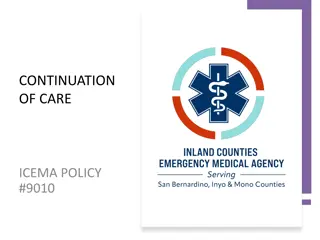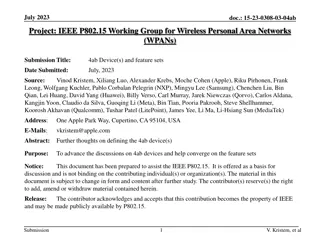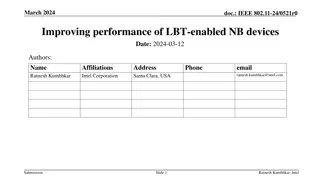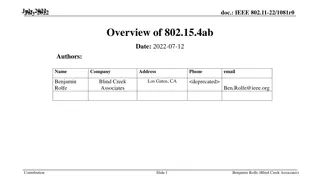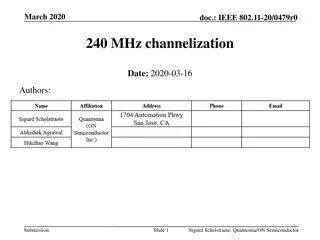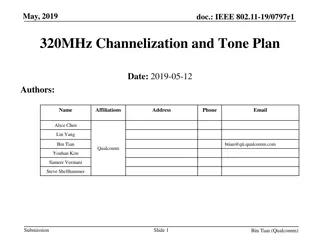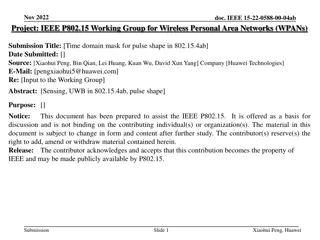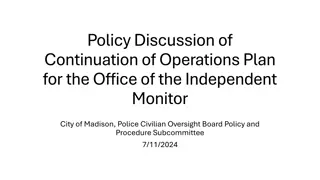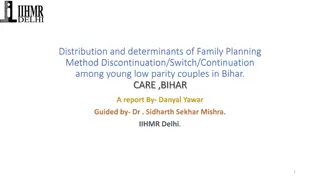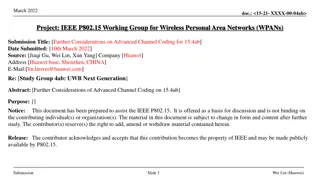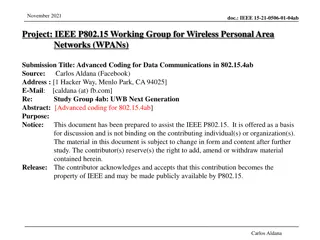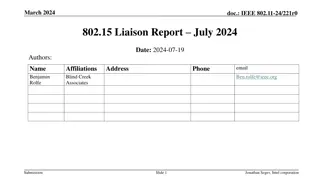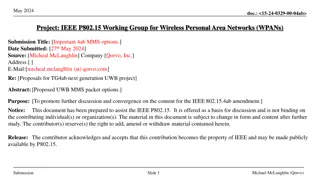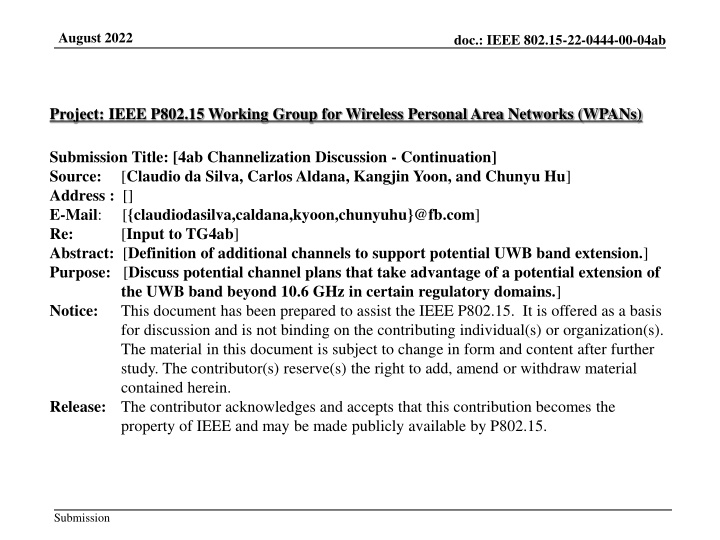
Discussion on Channelization for Potential UWB Band Extension
Explore the potential extension of the UWB band beyond 10.6 GHz with the definition of additional channels and operating frequencies in the IEEE 802.15-22-0444-00-04ab document. The document discusses channel plans, interference mitigation techniques, coexistence improvements, and more for high-integrity ranging and improved connectivity.
Download Presentation

Please find below an Image/Link to download the presentation.
The content on the website is provided AS IS for your information and personal use only. It may not be sold, licensed, or shared on other websites without obtaining consent from the author. If you encounter any issues during the download, it is possible that the publisher has removed the file from their server.
You are allowed to download the files provided on this website for personal or commercial use, subject to the condition that they are used lawfully. All files are the property of their respective owners.
The content on the website is provided AS IS for your information and personal use only. It may not be sold, licensed, or shared on other websites without obtaining consent from the author.
E N D
Presentation Transcript
August 2022 doc.: IEEE 802.15-22-0444-00-04ab Project: IEEE P802.15 Working Group for Wireless Personal Area Networks (WPANs) Submission Title: [4ab Channelization Discussion - Continuation] Source: [Claudio da Silva, Carlos Aldana, Kangjin Yoon, and Chunyu Hu] Address : [] E-Mail: [{claudiodasilva,caldana,kyoon,chunyuhu}@fb.com] Re: [Input to TG4ab] Abstract: [Definition of additional channels to support potential UWB band extension.] Purpose: [Discuss potential channel plans that take advantage of a potential extension of the UWB band beyond 10.6 GHz in certain regulatory domains.] Notice: This document has been prepared to assist the IEEE P802.15. It is offered as a basis for discussion and is not binding on the contributing individual(s) or organization(s). The material in this document is subject to change in form and content after further study. The contributor(s) reserve(s) the right to add, amend or withdraw material contained herein. Release: The contributor acknowledges and accepts that this contribution becomes the property of IEEE and may be made publicly available by P802.15. Submission
August 2022 doc.: IEEE 802.15-22-0444-00-04ab Technical Guidance PAR Objective Proposed Solution (how addressed) Safeguards so that the HDR use cases will not cause disruption to low duty-cycle ranging use cases. Interference mitigation techniques to support higher density and higher traffic use cases Other coexistence improvement Backward compatibility with enhanced ranging capable devices (ERDEVs). Improved link budget and/or reduced air-time Channelization to support potential UWB band extension Additional channels and operating frequencies Improvements to accuracy / precision / reliability and interoperability for high-integrity ranging; Reduce complexity and power consumption; Hybrid operation with narrowband signaling to assist UWB; Enhanced native discovery and connection setup mechanisms; Sensing capabilities to support presence detection and environment mapping; Low-power low-latency streaming higher data-rate streaming allowing at least 50 Mbit/s of throughput. Support for peer-to-peer, peer-to-multi-peer, and station-to-infrastructure protocols; Infrastructure synchronization mechanisms. Submission Slide 2
August 2022 doc.: IEEE 802.15-22-0444-00-04ab Background In our previous contribution [1], we discussed the fact that a potential extension of the UWB band beyond 10.6 GHz has been discussed in various organizations. For example, ETSI is currently working on an SRDoc (TR 103 750) that considers (t)echnical characteristics for UWB operation in the frequency band between 8.5 GHz to 10.6 GHz and 10.7 GHz to 12.4 GHz for various use cases. For this reason, we suggested in [1] defining additional channels and operating frequencies in the 4ab amendment so that 4ab devices may be able to use frequencies above 10.6 GHz. Notes: Implementations of the standard are limited by applicable regulatory requirements. Support to most channels defined for HRP/LRP UWB PHYs is optional. Submission Slide 3
August 2022 doc.: IEEE 802.15-22-0444-00-04ab Notes Based on feedback received, the channel plans discussed in this contribution are for 499.2 MHz channels. Some interest in possibly also defining overlapping channels and potentially wider channels. In this contribution, our main goal is to discuss baseline 499.2 MHz channels. Overlapping channels are also considered. The end frequency of the potential band extension is unclear. Different values, such as 12.4, 12.7 and 13.2 GHz, are considered. We consider channelization up to 13.2 GHz, but recognize that it may be appropriate to consider a lower end frequency in the draft amendment. Submission Slide 4
August 2022 doc.: IEEE 802.15-22-0444-00-04ab Technical Background 1/2 Center frequencies of all channels are integer multiples of 499.2 MHz Submission Slide 5
August 2022 doc.: IEEE 802.15-22-0444-00-04ab Technical Background 2/2 325 MHz < |f - fc| < 400 MHz (for 499.2 MHz) |f - fc| > 400 MHz (for 499.2 MHz) fc fc + 400 MHz fc + 325 MHz Submission Slide 6
August 2022 doc.: IEEE 802.15-22-0444-00-04ab Band Allocation Option 1 Channel number Centre frequency (MHz) Channel start frequency (MHz) Channel end frequency (MHz) Notes Channels currently defined in the IEEE 802.15 standard 13 9,484.8 9,235.2 9,734.4 14 9,984.0 9,734.4 10,233.6 N1 10,483.2 10,233.6 10,732.8 Option 1: 499.2 MHz channels. Advantage: Ease of implementation. Problem: Transmission in the passive sensing band (10.6-10.7 GHz) will be prohibited in most, if not all, regulatory domains. Solution: Channel N1 would have to be skipped. Even if this is the case, the start frequency of N2 would be too close to 10,700 GHz, resulting in stringent implementation requirements. N2 10,982.4 10,732.8 11,232.0 N3 11,481.6 11,232.0 11,731.2 N4 11,980.8 11,731.2 12,230.4 N5 12,480.0 12,230.4 12,729.6 Submission Slide 7
August 2022 doc.: IEEE 802.15-22-0444-00-04ab Band Allocation Option 1 10,233.6 10,732.8 11,232.0 11,731.2 12,230.4 12,729.6 14 N1 N2 N3 N4 N5 12,400 12,700 13,200 10,657.4 10,982.4 10,582.4 Considerations Channel N1 overlaps passive band Channel N2 may be too close to the passive band (0 dBr region in the transmit PSD mask partially overlaps the passive band). In practice, channel N2 may not be usable. If the band is extended to 12.4 GHz or 12.7 GHz, only 2 499.2 MHz channels could be considered to be usable (channels N3 and N4). For 13.2 GHz, 3 channels could be useful. Submission Slide 8
August 2022 doc.: IEEE 802.15-22-0444-00-04ab Band Allocation Option 2 Breaking from multiple of 499.2 MHz center frequency allocation may lead to better spectrum utilization. Infinite number of solutions exist. Below is an example of what could be achieved if a gap of 1.25x499.2 MHz is introduced to protect passive band. Channel number Centre frequency (MHz) Channel start frequency (MHz) Channel end frequency (MHz) Notes Channels currently defined in the IEEE 802.15 standard 14 9,984.0 9,734.4 10,233.6 N1 11,107.2 10,857.6 11,356.8 Option 2: 1.25x499.2 MHz gap is introduced to protect passive band Problem: Breaking from multiple of 499.2 MHz center frequencies increases implementation complexity Advantages: Protection passive band 3 499.2 MHz channels below 12.4/12.7 GHz N2 11,606.4 11,356.8 11,856.0 N3 12,105.6 11,856.0 12,355.2 N4 12,604.8 12,355.2 12,854.4 Submission Slide 9
August 2022 doc.: IEEE 802.15-22-0444-00-04ab Band Allocation Option 2 9,734.4 10,233.6 10,857.6 11,356.8 11,856.0 12,355.2 12,854.4 N2 14 N1 N3 N4 13,200 12,700 12,400 10,782.2 11,107.2 10,707.2 Center frequency of new channels are not integer multiples of 499.2 MHz; frequency separation between N1 and 14 is not 499.2 MHz (instead, is one and a quarter 499.2 MHz) If the band is extended to 12.4 GHz or 12.7 GHz, 3 499.2 MHz channels would be usable (channels N1, N2, and N3). For 13.2 GHz, 4 channels would be usable. Submission Slide 10
August 2022 doc.: IEEE 802.15-22-0444-00-04ab Overlapping Channels The definition/use of overlapping channels was discussed in [2]: Overlap somewhere between 25-75% may be desirable Carrier grid spacing of 124.8 MHz allows to choose between 124.8 MHz (N+1, i.e., ~75% overlap), 249.6 MHz (N+2, i.e., ~50% overlap), and 374.4 MHz (N+3, i.e., ~25% overlap) configurations The definition of overlapping channels would, by definition, lead to center frequencies that are not multiple of 499.2 MHz. Either of the two options previously considered can be extended to include overlapping channels. Note: Option 1 and option 2 are shifted by 124.8 MHz. Defining overlapped channels (with 124.8 MHz spacing) would unify both options. Submission Slide 11
August 2022 doc.: IEEE 802.15-22-0444-00-04ab Overlapping Channels 4 8 3 7 Example: 6 2 1 5 9 10,857.6 11,356.8 11,856.0 12,355.2 Channel number Centre frequency (MHz) Channel start frequency (MHz) Channel end frequency (MHz) Channel number Centre frequency (MHz) Channel start frequency (MHz) Channel end frequency (MHz) 5 11,606.4 11,356.8 11,856.0 1 11,107.2 10,857.6 11,356.8 6 11,731.2 11,481.6 11,980.8 2 11,232.0 10,982.4 11,481.6 7 11,856.0 11,606.4 12,105.6 3 11,356.8 11,107.2 11,606.4 8 11,980.8 11,731.2 12,230.4 4 11,481.6 11,232.0 11,731.2 9 12,105.6 11,856.0 12,355.2 Submission Slide 12
August 2022 doc.: IEEE 802.15-22-0444-00-04ab Conclusion In this contribution, we discussed factors that impact the definition of a channel plan for frequencies beyond 10.6 GHz. Two channel plan examples were offered. Feedback is welcome. Submission Slide 13
August 2022 doc.: IEEE 802.15-22-0444-00-04ab References [1] 22/0330r0, 4ab Channelization Discussion, July 2022. [2] 22/0175r0, Sensing Device, March 2022. Submission Slide 14

